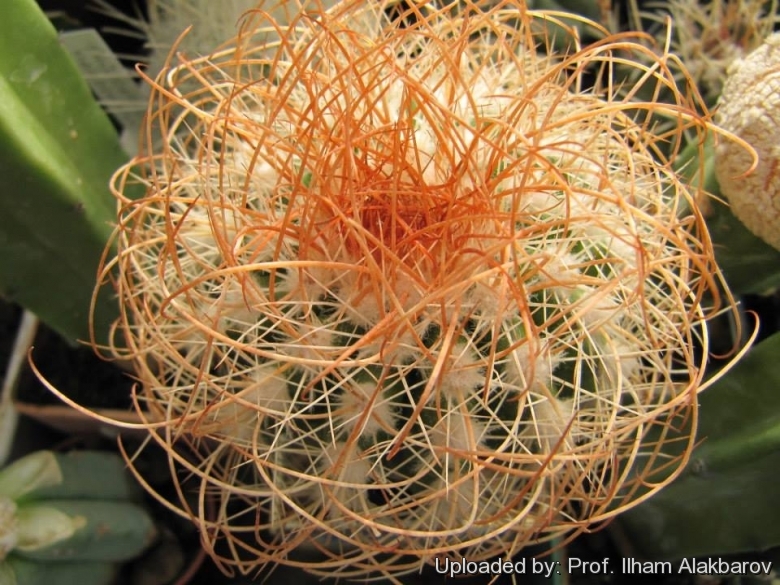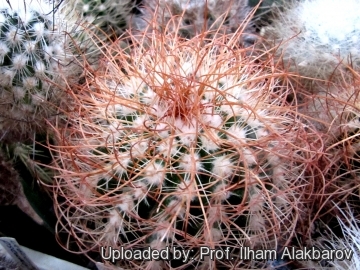= Parodia rubida F.Ritter
Succulenta (Netherlands) 1964: 43.
Accepted Scientific Name: Parodia ritteri Buining
Succulenta (Netherlands) 1959, 17 (1959).

Parodia maassii var. rubida (Parodia rubida) Photo by: Prof. Ilham Alakbarov
Origin and Habitat: Potosí and Chuquisaca, Bolivia
Type locality: Near La Torre, dept. Chuquisaca (Bolivia). FR 725
Altitude: Around 2400-2800 metres above sea level.
Habitat and Ecology: Parodia rubidaSN|5839]]SN|5839]] grows on steep wooded rocky area and low west facing sandstone slopes.
Synonyms:
See all synonyms of Parodia ritteri
back
Accepted name in llifle Database:Parodia ritteri BuiningSucculenta (Netherlands) 1959, 17 (1959).Synonymy: 17
back
Description: Parodia rubidaSN|5837]]SN|5839]] is a nice morphological form of the variable Parodia ritteriSN|5839]]SN|5837]] distinguished for the heavy central spines varying from light tan to reddish-brown. The most popular, however, are specimens with reddish spines, which also gave the species name.
Stem: 150-160 mm Ø, with a crown of white wool.
Ribs: Mostly 13, rarely up to 16, 15-20 mm high.
Areoles: With white felt.
Spines: Orange-yellow to reddish-brown.
Radial spines: 12-16 light cream-brown to white, thin, needle-like, 20-50 mm long, upper and lower ones roughly equally long.
Central spines: 3-6, stronger than radials, 30-70 mm long, lower ones longer the other a little shorter, in younger plants the lower central noticeably hooked, in mature plants only slightly curved to almost straight.
Flowers: 25-40 mm long brownish-orange, but also in various shades of pink, tepals 12-20 mm long and 2-4 mm broad, central strip more or less pronounced, crimson, 1-2 mm wide, wider downward, margins of tepals brownish. Pericarpel spherical, 6-7 mm, wrapped in white woolly hairs; floral-tube 11-15 mm long, 11-13 mm wide white, red and brown more or less densely covered by white woolly hairs often lacking; filaments basally yellow reddish-brown above, pistil pale yellow protruding above the anthers.
Fruits: Spherical, covered with fine white wool, with broad basal opening at maturity.
Seeds: Ovoid, 1.0 x 0.8 mm, black, finely tubercled.
Subspecies, varieties, forms and cultivars of plants belonging to the Parodia ritteri group
- Parodia ritteri Buining
 Parodia roseoalba F.Ritter: has conspicuous creamy-white, yellow or amber central spines that envelop the body. Flowers yellow to orange or pinkish. Distribution: Chuquisaca and Tarija, Bolivia.
Parodia roseoalba F.Ritter: has conspicuous creamy-white, yellow or amber central spines that envelop the body. Flowers yellow to orange or pinkish. Distribution: Chuquisaca and Tarija, Bolivia. Parodia rubida F.Ritter: has heavy central spines varying from light tan to reddish-brown. Flowers brownish-orange. Distribution: Potosí and Chuquisaca, Bolivia.
Parodia rubida F.Ritter: has heavy central spines varying from light tan to reddish-brown. Flowers brownish-orange. Distribution: Potosí and Chuquisaca, Bolivia.
Bibliography: Major references and further lectures
1) Backeberg C. "Das Kakteenlexikon" p. 348, 1966
2) De Vos W. "Parodia rubida" Cactusvrienden, 22 : 128-200, 1982
3) Jelínek J. "Parodia Speg.;" Kaktusy 79, 15 : 113, 1979
4) Kessler H., "Parodien aus den bolivianischen Anden" Kakt. und and. Sukk., 21 : 70, 1970
5) Kessler H., "Die FR-Parodien" Stachelpost, 7 : 223-224, 247, 1970
6) Ritter F., "Kakteen in Südamerika" 2 : 519, 1980
7) Weskamp W., "Die Gattung Parodia" p. 283-284, 1987
8) Lowry, M. & Carr, J. 2013. Parodia ritteri. In: IUCN 2013. “IUCN Red List of Threatened Species.” Version 2013.2. <www.iucnredlist.org>. Downloaded on 28 February 2014.
9) Edward Anderson “The Cactus family” Timber Press, Incorporated, 2001
10) James Cullen, Sabina G. Knees, H. Suzanne Cubey "The European Garden Flora Flowering Plants: A Manual for the Identification of Plants Cultivated in Europe, Both Out-of-Doors and Under Glass" Cambridge University Press, 11/Aug/2011
11) David R Hunt; Nigel P Taylor; Graham Charles; International Cactaceae Systematics Group. "The New Cactus Lexicon" dh books, 2006
12) Urs Eggli, Leonard E. Newton “Etymological Dictionary of Succulent Plant Names” Springer, Berlin/Heidelberg 2010
13) Václav Drbal of Moravian, Zden?k Vorá?ek. Miroslav Veverka. “Parodia rubida Ritt.” <http://www.cact.cz/galerie_test/detail.php?id=424 > Downloaded on 28 February 2014.
 Parodia maassii var. rubida (Parodia rubida) Photo by: Prof. Ilham Alakbarov
Parodia maassii var. rubida (Parodia rubida) Photo by: Prof. Ilham AlakbarovSend a photo of this plant.The gallery now contains thousands of pictures, however it is possible to do even more. We are, of course, seeking photos of species not yet shown in the gallery but not only that, we are also looking for better pictures than those already present.
Read More... Cultivation and Propagation: Parodia rubidaSN|5839]]SN|5839]] is relatively easy to grow on its own roots.
Soil: Grow it in an open sandy-gritty cactus compost.
Pots: It needs a relatively shallow pot to accommodate its fibrous roots and provide a very good drainage. It may stay in the same pot for many years.
Watering: Water in moderation, it prefer a completely dry place during winter. Mature individuals easily rot and die especially after planting so be extremely cautious with watering. Keep dry in winter or when night temperatures remain below 10° C. Water it less than average if in bigger pots.
Special need: Provide very good ventilation. Nearly all problems occur as a result of overwatering and poor ventilation, especially when weather conditions are dull and cool or very humid.
Fertilization: Feed them once during the growing season with a fertilizer specifically formulated for cactus and succulents (high potash fertilizer with a dilute low nitrogen), including all micro nutrients and trace elements diluted to ½ the strength recommended on the label. They thrive in poor soils and need a limited supplies of fertilizer to avoid the plants developing excess vegetation, which is easily attacked by fungal diseases.
Exposure: It will do its best with lots of sun and become stressed with inadequate light which could result in poor growth and unnatural shape.
Hardiness: It likes warmth (recommended minimum winter temperature 5° C) however plants kept perfectly dry can can survive low temperatures, approx. -5°, but for safe cultivation it is best to avoid freezing temperatures.
Use: This is a good pot plant suited for a non heated green house. It can be also cultivated outdoors in raised beds, terraces if sheltered from winter rain. This cactus continues to be, a particular prize among collectors
Pests & diseases: These cacti may be attractive to a variety of insects, but plants in good condition should be nearly pest-free, particularly if they are grown in a mineral potting-mix, with good exposure and ventilation. Nonetheless, there are several pests to watch for:
- Red spiders: Red spiders may be effectively rubbed up by misting the plants from above.
- Mealy bugs: Mealy bugs occasionally they develop aerial into the new leaves and flowers with disfiguring results, but the worst types develop underground on the roots and are invisible except by their effects.
- Rot: Rot is only a minor problem if the plants are watered and “aired” correctly. If they are not, fungicides won't help all that much.
Propagation: Seeds. The seeds can be sown in pots of fine, well-drained sandy soil, any time during the spring when temperatures are warm. Cover the seeds with a fine layer of grit and water from below with a fungicide to prevent damping off. For the 1-2 weeks cover the pots with a sheet of glass/clear perspex to keep the humidity levels high. Remove the glass and replace it with light shade-cloth and mist once or twice a day for the next two weeks after which most seeds should have germinated. From then on mistings can be reduced to every second and then every third day as the little plants grow.












